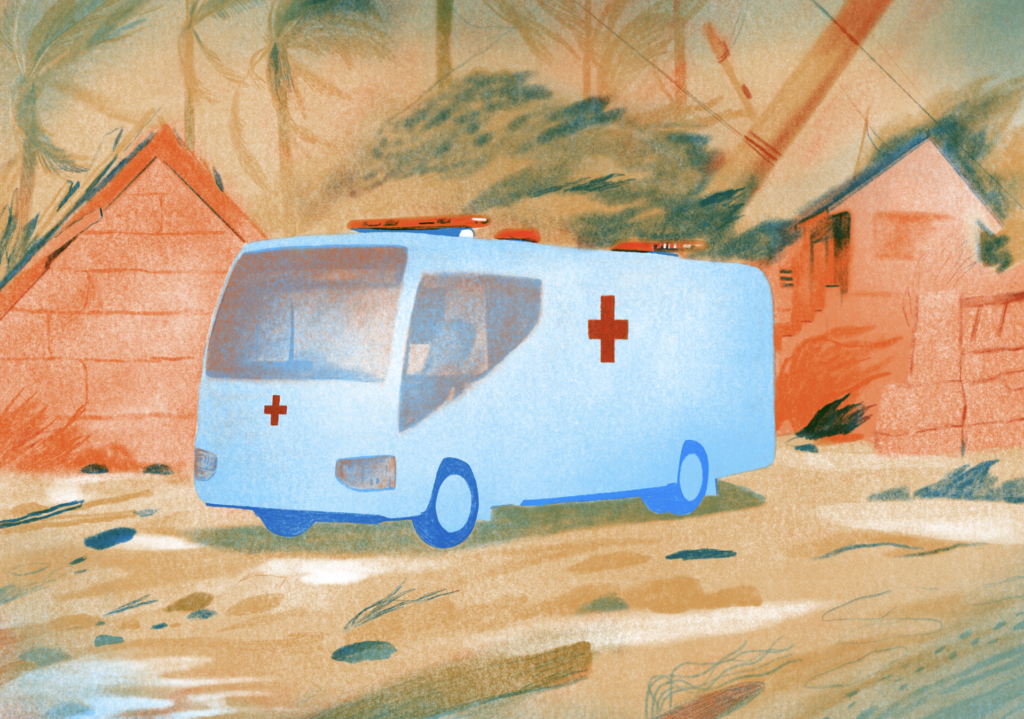
Illustration: Pau Gasol Valls
Description
Japanese Red Cross Kumamoto Hospital and Toyota Motor Corporation begin demonstration testing of the world’s first fuel cell electric mobile clinic. The organizations aim to use this demonstration testing to confirm the effectiveness of a commercial fuel cell electric vehicle in areas of medicine and disaster response, and to achieve carbon neutrality.
Context
Japanese Red Cross Kumamoto Hospital’s basic policy is “to assess natural disasters from a global perspective and to be involved actively in medical relief activities.” Operating as the Japanese Red Cross’s first international medical relief hospital, it has participated in relief efforts for victims of warfare and natural disasters around the world. In addition, the hospital is implementing environmental measures in its day-to-day hospital management.
In view of these underlying policies, Toyota and Japanese Red Cross Kumamoto Hospital have been studying the efficacy of commercial Fuel Cell Vehicles for use in medical treatment and disaster response and conducting repeated studies into the creation of new value. As a result, the two reached an agreement that the development of a sustainable operational model of the Fuel Cell Vehicle mobile clinic for regular medical treatment activities and effective use during disasters will help resolve issues associated with natural disasters.
Technical details & Operations
In consultation with the International Medical Relief Department of Japanese Red Cross Kumamoto Hospital, Toyota has developed the mobile clinic based on its Coaster minibus, with the power source using the Toyota fuel cell system that uses hydrogen, employed by the “Mirai” Fuel Cell Vehicle. On the road, it exhibits superior environmental performance with no CO2 emissions or substances of concern, while offering a low-noise, low-vibration driving experience.
With multiple 100 VAC accessory power outlets supplied not only inside the vehicle but also outside the cabin, the vehicle is able to supply electricity to a variety of electrical products. It is also equipped with an external DC electric power supply system that delivers a high-output, large-capacity supply of power (9 kW max output, approx. 90 kWh supply capacity). Inside, the vehicle combines air conditioning with an exhaust system and HEPA filter to improve infection control for occupants when working.
| Vehicle | Length / width / height | 7,160 mm / 2,105 mm / 2,795 mm |
|---|---|---|
| Gross vehicle weight | 5,670 kg | |
| Maximum speed | Approx. 100 km/h | |
| Cruising range | Approx. 210 km | |
| FC stack | Quantity | 1 |
| Maximum output | 114 kW/155 PS | |
| Motor | Quantity | 1 |
| Maximum output | 134 kW/182 PS | |
| Maximum torque | 300 N・m (34.2 kgf・m) | |
| High-pressure hydrogen tank | Number of tanks | 3 tanks |
| Hydrogen storage mass | 7.2 kg | |
| Power supply | Type and output | AC 100 V, 9 kW max |
| DC (CHAdeMO), 9 kW max | ||
| Power supply amount | Approx. 90 kWh |
Deployment & Impact

Toyota manufactures the mobile clinic, loans the vehicle to Japanese Red Cross Kumamoto Hospital, and provides technical support for the vehicle.
The Hospital manages the mobile clinic on loan from Toyota for trial use in actual medical care situations, disaster drills, etc., to identify advantages and disadvantages of the Fuel Cell Vehicles in society.
The fuel cell technology and its system are promising technology, as it can generate large-scale electricity that is well suited for application in a wide range of purposes such as passenger cars, commercial vehicles, industrial vehicles, stationary fuel cell generators and relief equipment as the Red Cross Emergency Response Units. It is also environmentally friendly technology, being able to reduce environmental burdens toward the Zero Emission Society.





